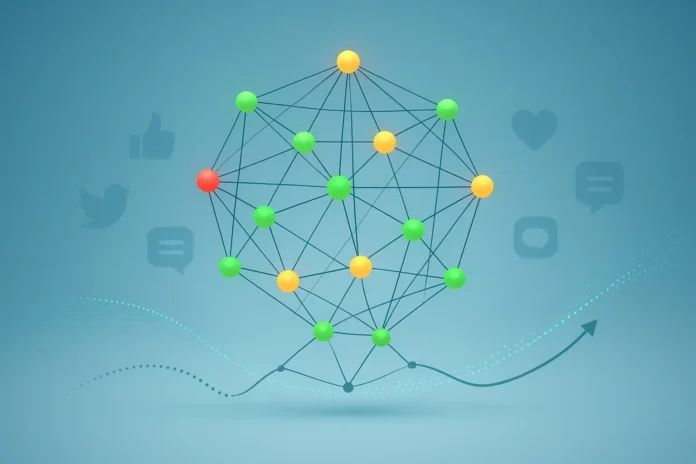Social Media Sentiment Analysis: Emotional Trends that Shape Strategy
This article explores how emotional trends shape strategic decision-making across digital communications, featuring expert insights on sentiment analysis techniques and applications. Tracking audience feelings through NLP analysis reveals powerful patterns that companies can leverage for more effective marketing and customer support. Research shows that understanding emotions like nostalgia, frustration, and skepticism enables brands to create more transparent, accessible, and audience-aligned content strategies.
- Control Concerns Lead to Transparent Bot Design
- Nostalgia Drives Authentic Real Estate Marketing
- Track Sentiment to Align with Audience Feelings
- Solution Fatigue Prompts Clarity-Focused Message Shift
- Warranty Skepticism Transforms Product into Partnership
- Context Over Jargon Creates Accessible Tech Content
- NLP Analysis Reveals Regional Fan Sentiment Patterns
- Frustration Signals Shift From Features to Support
Control Concerns Lead to Transparent Bot Design
We tested an idea to make our chatbot more autonomous and used social media to gauge the reaction before building. We posted a short demo on LinkedIn and a founder thread on Reddit, then pulled all comments and quotes into one place. We ran simple sentiment and emotion tagging to separate excitement from concern, and read the highest impact comments by hand to understand the why behind the scores. One emotion dominated. People felt a loss of control when they saw the word “autonomous.” The concern was not technical. It was emotional trust. Would the bot make the wrong promise or drift from brand voice?
That signal changed our plan. We reframed the feature from “autonomous” to “assisted.” The default became “act with guardrails and ask for approval when stakes are high.” We added a visible “show your work” panel so people could see what the bot looked up, which policy it matched, and why it chose a response. We renamed “auto resolve” to “assist then confirm” and led our messaging with control and audit trail rather than magic. After that shift, sentiment turned positive, demo completion rose, and we booked pilot calls faster. Sentiment analysis did not replace judgment. It told us which emotion to resolve first so our product and story met people where they were.

Nostalgia Drives Authentic Real Estate Marketing
We once launched a carousel that focused on emotion rather than traditional sales tactics. Our concept asked, “What does a home remember?” instead of highlighting prices or creating urgency, a different approach in the real estate space.
To validate this idea before scaling it, I conducted sentiment analysis across Instagram and Pinterest, analyzing thousands of comments, shares, and saves. This wasn’t just about collecting metrics; it was about understanding the emotional response. The data confirmed what we suspected: people were experiencing advertising fatigue and craved authentic connection.
Nostalgia emerged as the dominant emotional trend. Content that evoked memories, legacy, or sensory experiences generated exceptional engagement. People weren’t just liking these posts — they were sharing personal stories, like how their grandmother’s spice box still occupies a special place in their kitchen today.
This insight fundamentally reshaped our strategy. We embraced memory as our central theme, made our copy more subtle, and warmed up our visuals. We shifted from selling homes to telling stories of belonging. The experience taught me that effective sentiment analysis isn’t about charts and graphs; it’s about understanding the emotional spaces between interactions.

Track Sentiment to Align with Audience Feelings
When we launched a content campaign around personal branding for founders, we used sentiment analysis to track public reception on social media. We specifically monitored how audiences felt about the concept of “founders becoming the face of their brand.”
Initially, responses were split; some showed admiration while others displayed clear hesitation. Our analysis revealed a consistent emotional trend: vulnerability.
This insight fundamentally changed our content strategy. We pivoted to framing personal branding as “confidence with boundaries” rather than oversharing. The results were immediate: engagement increased substantially, and our message resonated much better. The success wasn’t from changing our core idea, but from aligning our approach with what people were actually feeling.

Solution Fatigue Prompts Clarity-Focused Message Shift
I once tested the positioning for a new service we were preparing to roll out. Before finalizing anything, I monitored online conversations around similar offers and the problems people were voicing. Instead of just looking at volume and engagement, I paid attention to the tone behind the comments.
What stood out wasn’t dislike or disinterest; it was fatigue. People were tired of complicated solutions that created more work instead of simplifying it. That emotional undertone made us rethink how we framed the offer. Rather than promoting features and performance, we shifted the message toward clarity, ease, and support.
By the time we launched, the reception aligned much more closely with what people actually wanted, not a “powerful system,” but relief from overwhelm. That experience reminded me that sentiment analysis isn’t just about approval, but intent and emotion.
Sometimes the strategy that works isn’t the one you planned; it’s the one the audience is already asking for without saying it directly.

Warranty Skepticism Transforms Product into Partnership
For a long time, social media felt like a simple product catalog. We would measure vanity metrics, but it did nothing to validate our ideas. We were talking at our audience, not with them.
We used sentiment analysis on discussions regarding the launch of a new OEM Cummins Turbocharger line. The role a strategic mindset played in shaping our brand is simple: it has given us a platform to show, not just tell. Our core brand identity is based on the idea that we are a partner to our customers, not just a vendor.
The surprising emotional trend that significantly impacted our strategy was a pervasive feeling of skepticism about warranty claims. Users didn’t doubt the product; they doubted the operational follow-through. This forced us to stop promoting features (Marketing) and start guaranteeing system integrity (Operations). We created a new process where every ad highlighted the simplicity of the 12-month warranty claim process.
This has been incredibly effective. Our brand is now defined by the quality of our operational support, which is a much more authentic way to build a brand. The social media campaign is no longer a broadcast channel; it’s a community of experts, and we’re just the host.
My advice is that you have to stop thinking of sentiment analysis as a way to promote your product and start thinking of it as a platform to celebrate your customers’ operational success. Your brand is not what you say it is; it’s what your customers say it is.

Context Over Jargon Creates Accessible Tech Content
We actually did this when we were experimenting with new livestream formats. We weren’t sure if people wanted a deep-dive technical hour or something lighter and more scenario-based. To get a read, we monitored comments and reactions across LinkedIn, Twitter (X), Substack, Instagram, Facebook, Twitch, Kick, and YouTube using sentiment analysis tools. Instead of just counting likes, we looked at the tone of responses — whether people felt “confused,” “excited,” or “overwhelmed.”
One emotional trend that really stood out was frustration whenever the conversations got too technical without context. People expressed things like, “This is too much jargon,” or, “I don’t follow.” On the other hand, when we framed the same topic in a real-world scenario — like, “imagine someone in your company accidentally shares a sensitive file externally” — the sentiment shifted toward engagement and relief, because the content felt more accessible.
That insight changed our strategy: we started scripting shows with more story-driven explanations, always tying back to practical scenarios before diving into features. It’s not just about presenting information; it’s about making people feel included. Sentiment analysis helped us see that clearly and adapt in a way that improved both the show and the audience experience.

NLP Analysis Reveals Regional Fan Sentiment Patterns
While consulting on a data analytics project, I conducted sentiment analysis on approximately 5,000 tweets regarding fan reactions to a new Premier League pay-per-view model. Our NLP analysis in R identified strong negative sentiment patterns, with terms like “Scrap” and “Boycottppvlive” appearing frequently across the dataset. The discovery that Aston Villa, Arsenal, and Chelsea supporters displayed particularly low sentiment scores provided valuable intelligence that helped our client understand the varying regional reception to their pricing strategy and ultimately influenced their market-specific approach to the service rollout.

Frustration Signals Shift From Features to Support
When we were figuring out how to talk about our company, we didn’t just track clicks or open rates; we studied franchisee conversations online. What stood out wasn’t excitement about new software. It was frustration. Owners felt like once they signed the deal, they stopped being heard.
That insight changed our approach. We stopped talking about features and started talking about support; building tools that make franchisees feel like they have a real voice in the system.
If you pay attention to the emotional signals in the conversations people are already having, you’ll uncover the problems they actually want solved.


